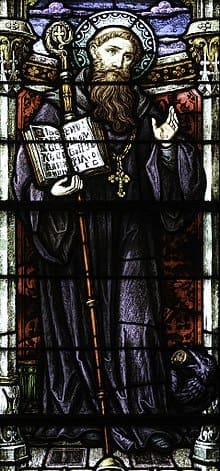While some of us certainly consider kicking back with a cold beer at the end of a long day to be a religious experience, most of us don’t think of beer as having particularly strong religious associations. Wine gets plenty of glory as an instrumental part of Communion, but it turns out that some beer also has a deep connection to religion that dates all the way back to the sixth century.
You’ve probably heard of (and hopefully have sampled) Trappist ales, and for the monks who brew it, this beer is more than just a refreshing beverage; it’s a physical manifestation of spiritual and contemplative devotion. In this series on Trappist beer, we’ll explore the history, the breweries, and the legacy – starting with an overview of the Trappists and how a guy named Benedict inadvertently became responsible for some of the best beers in the world.
TRAPPIST EARLY HISTORY
Trappists – also sometimes called Trappistines – are part of the Order of Cistercians of the Strict Observance, which began in 1098. A branch of Catholicism, this group of cloistered monastics is unique because of its strict interpretation of the Rule of Benedict as the guiding principle for the lives of nuns and monks who are part of the order.
 Back in the sixth century, Benedict of Nursia wrote the Rule of St. Benedict, which provided specific lifestyle guidelines for monks and nuns. The rule, which is actually a detailed series of many rules, covered everything from how often they should pray and how they should sleep to the times of day they were allowed to eat and drink. Some of the overarching ideas include:
Back in the sixth century, Benedict of Nursia wrote the Rule of St. Benedict, which provided specific lifestyle guidelines for monks and nuns. The rule, which is actually a detailed series of many rules, covered everything from how often they should pray and how they should sleep to the times of day they were allowed to eat and drink. Some of the overarching ideas include:
- monks should spend a significant amount of time in spiritual reflection and observance
- monks should engage in manual labor to balance that reflection
- monasteries should be financially self-supporting
- secular (worldly) pursuits should be avoided
For the Trappists, the Rule of St. Benedict established the tradition of “ora et labora,” which translates to “prayer and work” – the two tenets on which Trappist monks and nuns continue to focus their lives today.
This Rule of St. Benedict established the guidelines by which monks and nuns lived for many centuries, but each order interpreted the rule differently. Looking for a strict interpretation, Saints Robert, Alberic, and Stephen founded the Citeaux monastery near Dijon, France, in 1098 as a reformed community that rigidly followed Benedict’s rule. Over the years, there were additional reforms, including one in the 17th century led by the Abbot of La Trappe in Normandy, which is how the “Trappists” got their name.
Monks and nuns who live by the rule of St. Benedict are required to spend much of the day performing manual labor to support the monastery and the community. Over the years, many monasteries started creating products they could sell to achieve that goal, and today, popular Trappists goods range from cheese and bread to chocolate and honey – and of course, Trappist beer.
In Stan Hieronymus’ book Brew Like a Monk, he credits St. Benedict’s rule is the sole reason why monks brew and sell beer. Brewing became a way to simultaneously pursue manual labor and support the monastery and community needs. Hieronymus believes this commitment to brewing eventually spread to the rest of Belgium and may explain why the rest of the country is so prolific when it comes to creating beer.
THE STORY OF TRAPPIST BEER
According to the American Homebrewers Association, Trappist beer may have originally been brewed as a form of potable water for the monks – but it quickly became popular outside the monastery walls. Selling the beer within the local community and beyond became an easy way for the monks to earn enough money to maintain the monastery and support their personal needs.
The tradition of Trappist beer continued smoothly until the French Revolution took hold of France in the early 1800s. As upheaval took hold of the region, monasteries were sacked and looted and monks were forced to abandon their breweries. Over the next hundred years, the Trappists settled in Belgium and began to refocus their efforts on monastic life, resuming beer production as a way to restore and support the monasteries.
PROTECTING TRAPPIST AUTHENTICITY
By the mid 1900s, Trappist beers had become known around the world for their high quality and limited production – and suddenly, the brews started popping up everywhere. While some producers actually did work with monks to distribute the monastery-crafted beers, many entrepreneurs simply monopolized on the trend, using monks or monasteries on their labels, naming the beer after holy figures, and collecting the profits for themselves.
The issue came to a head in 1960, when the Abbaye Notre Dame d’Orval filed a legal claim against the Veltem brewery of Leuven to stop the production of “Veltem Trappist.” The Belgian courts sided with the monastery and decided that to be called “Trappist,” a beer must be brewed and sold by monks who are actually members of the Trappist order. Other beers in the Trappist style would instead be called “abbey beer.”
 To further protect this designation for beer and other Trappist products, the International Trappist Association (ITA) was formed by eight Trappist abbeys in 1997 to regulate how the name can be used and how goods are sold. Only abbeys that have become members of the ITA are allowed to legally and legitimately sell Trappist goods using the “Authentic Trappist Product” designation and logo.
To further protect this designation for beer and other Trappist products, the International Trappist Association (ITA) was formed by eight Trappist abbeys in 1997 to regulate how the name can be used and how goods are sold. Only abbeys that have become members of the ITA are allowed to legally and legitimately sell Trappist goods using the “Authentic Trappist Product” designation and logo.
For an abbey to become a member of the ITA, it must submit an application and then undergo a thorough evaluation by the ITA Board of Directors, which includes onsite visits. The directors evaluate the abbey’s production process to make sure it adheres to Trappist regulations and quality and sample the goods to ensure they’re worthy of the Trappist name. An abbey that is accepted into the International Trappist Association receives an ATP license and can use the Authentic Trappist Product designation and logo for five years.
OFFICIAL TRAPPIST ALES
To be designated a Trappist beer, the ITA established the following criteria:
- Brewing must take place inside the walls of a Trappist monastery and be performed or supervised by monks.
- Operations of the brewery must come second to the religious pursuits of the monastery and should be conducted in a way that aligns with monastic life.
- Profits from the beer should be used only to sustain the monastery and its residents, with any excess used to help the needs of the community – but breweries may not make profits.
According to the ITA, there are 11 breweries that create certified Trappist ales – and there are 12 beers that are allowed to carry the name Trappist. Because Mont de Cats beer is brewed offsite at the Abbaye Notre-Dame de Scourmont, it’s not allowed to bear the Authentic Trappist Product logo, but it is considered a Trappist beer by the ITA. As of 2018, the complete list of Trappist beers and their corresponding breweries are:
Austria
Gregorius and Benno, brewed by Stift Engelszell
Belgium
Chimay, brewed by Abbaye Notre-Dame de Scourmont
Orval, brewed by Abbaye Notre-Dame d’Orval
Rochefort, brewed by Abbaye Notre-Dame de St. Remy
Westmalle, brewed by Abdij der Trappisten Westmalle
Achel, brewed by St Benedictus-Abdij
Westvleteren, brewed by St Sixtus Abdij
France
Mont des Cats, brewed at the Abbaye Notre-Dame de Scourmont in Belgium in partnership with Mont des Cats
The Netherlands
La Trappe, brewed by Abdij Onze Lieve Vrouw van Koningshoeven
Zundert, brewed by Zundert Maria Toevlucht Abbey
Italy
Tre Fontaine, brewed by Abbazia delle Tre Fontane
United States
Spencer, brewed by Saint Joseph’s Abbey – Spencer
With such a rich and storied history, there’s no denying the Trappists helped to shape brewing in Belgium and beyond. In our next installment, we’ll explore the unique characteristics of each Trappist brewery and the beers they create. In the meantime, raise your glass to the Trappists and St. Benedict for the glorious brews known as Trappist ale.

Reader Interactions